Utilizing Light to Deter Mosquitoes Effectively
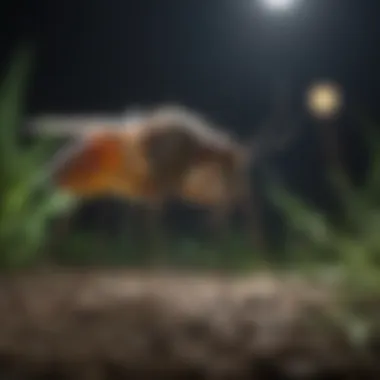
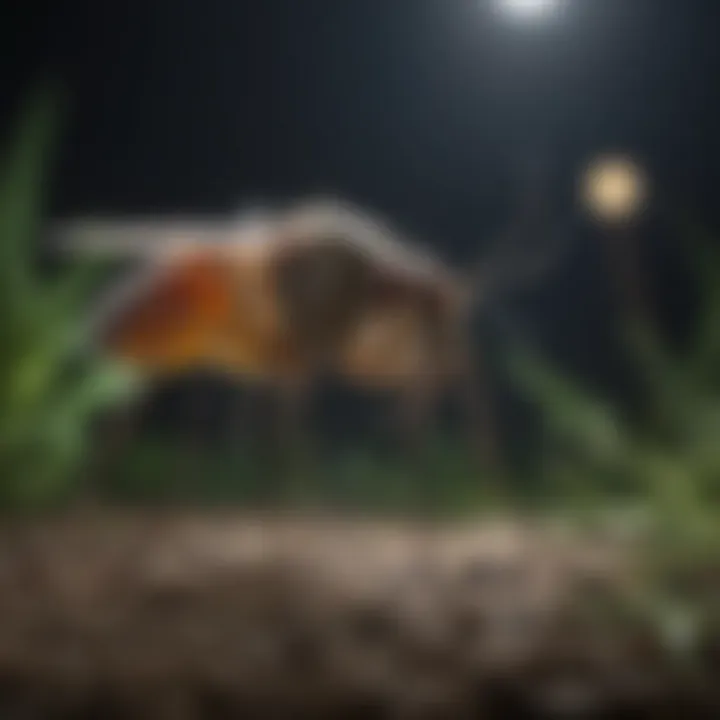
Intro
Mosquitoes pose a persistent nuisance for many homeowners, especially during warm months when outdoor spaces become inviting. Traditional methods of mosquito control often involve harsh chemicals or unpleasant traps. However, recent studies have explored a more subtle and potentially safer approach: utilizing light as a deterrent. This article investigates how various light sources impact mosquito behavior, offering evidence-based strategies that can enhance outdoor living.
Understanding the relationship between light and mosquito attraction is crucial. Research indicates that certain wavelengths of light can either attract or repel these pests. This guide aims to provide practical insights for homeowners, interior designers, party hosts, and garden enthusiasts looking to optimize their spaces with appropriate lighting techniques.
As we delve into this topic, we shall explore key insights about the latest trends in lighting choices, alongside practical tips that lead to more effective mosquito management. By highlighting the effective use of light, one can not only enhance the ambiance of outdoor areas but also create a more enjoyable environment free from mosquito interference.
Key Insights and Trends
Understanding Mosquito Behavior and Light Spectrum
Recent research has established that mosquitoes, particularly species such as Aedes aegypti, are heavily influenced by light spectra. For instance, ultraviolet (UV) light tends to draw them in, while certain shades of yellow and red may act as deterrents. Homeowners keen to minimize mosquito intrusion should consider these findings in their outdoor lighting strategies.
Lighting Technologies
Innovative lighting technologies are emerging with features aimed at reducing mosquito presence. LED lights, which come in various colors, have gained popularity. Their energy efficiency, durability, and low heat emission make them ideal for outdoor settings. More importantly, they can be specifically designed to emit wavelengths less appealing to mosquitoes.
- Some options include:
- Yellow or amber LED lights
- Solar-powered garden lights
- Smart lighting systems that adjust intensity and color
Integrating these technologies can transform outdoor spaces and reduce the need for chemical repellents.
Lighting and Landscape Design
Effective landscape design can significantly influence mosquito behavior. The placement of lights can enhance or mitigate their attraction. Pathway lights, for example, should ideally emit colors that repel mosquitoes while illuminating walking areas. Additionally, it is helpful to direct lights away from resting places where mosquitoes may dwell, like shrubs or tall plants.
"Adjusting light settings not only improves the aesthetics of a garden but also helps in managing pest populations effectively."
Practical Tips and How-To Guides
Step-by-Step Guide to Choosing the Right Light
- Assess the outdoor space to identify areas prone to mosquito activity.
- Select light fixtures that utilize yellow or amber LED bulbs.
- Arrange lights strategically to focus on pathways and social areas, minimizing light near vegetation.
- Consider motion sensor lights that can offer illumination without constant attraction.
- Maintain the lighting to ensure dirt or bugs do not interfere with effectiveness.
Entertaining Tips for Outdoor Spaces
- Use string lights in warm tones to create ambiance while keeping mosquitoes at bay.
- Incorporate citronella candles alongside lighting, as the scent also deters mosquitoes.
- Plan outdoor gatherings during times when mosquitoes are less active, such as during windy days, to enjoy the space even more.
By utilizing knowledge about the relationship between light and mosquitoes, homeowners can effectively manage their outdoor environments. The strategies outlined in this guide are based on scientific understanding and practical application, ensuring a refined approach to mosquito control.
Preface to Mosquito Behavior
Understanding mosquito behavior is vital to developing effective deterrent strategies. Mosquitoes are not just pests; they are vectors for diseases. Hence, comprehending their attraction mechanisms can lead to targeted prevention methods.
The Role of Light in Mosquito Attraction
Light plays a significant role in attracting mosquitoes. Research suggests that different light wavelengths affect mosquito behaviors in varying ways. For example, certain ultraviolet (UV) lights can draw more mosquitoes than others.
This relationship stems from the mosquitoes' evolutionary adaptation to their environment. They often use light as navigational cues for finding food sources or safe havens. Knowledge of this dynamic allows homeowners to manipulate light sources to create less inviting environments for these insects. Some studies indicate that warm white or amber lights produce less attractive signals for mosquitoes compared to cooler temperatures.
"By understanding how light influences mosquito behavior, we can create smarter ecosystems in our outdoor spaces."
Understanding Mosquito Habitats
To deter mosquitoes effectively, one must grasp their preferred habitats. Mosquitoes thrive in moist environments with standing water, where they lay eggs. Gardens, ponds, and poorly drained areas often serve as ideal breeding grounds. Understanding these habitats can help us develop targeted strategies not only to manage mosquitoes but also to design our outdoor spaces with these creatures in mind.
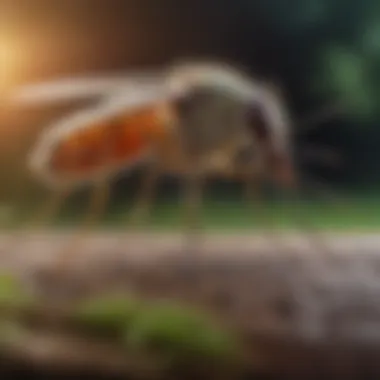
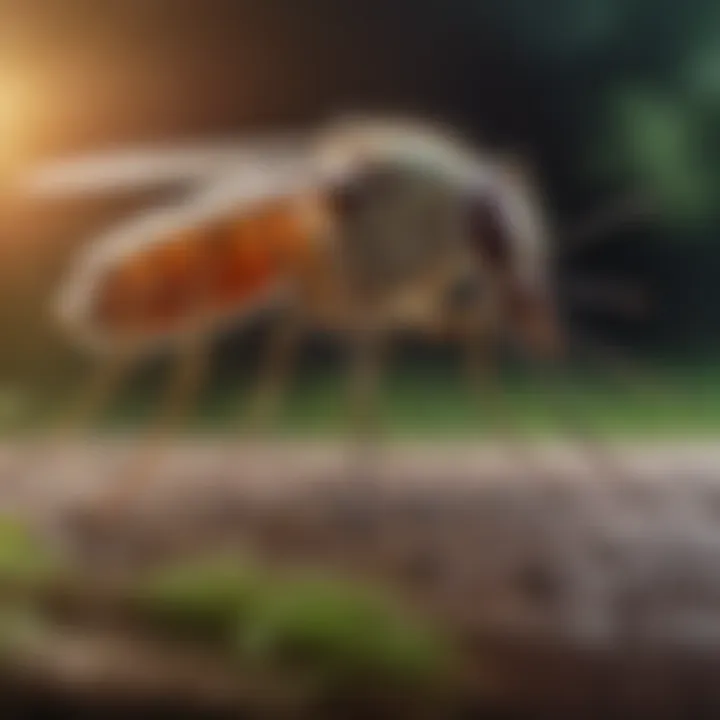
Consideration of landscaping is crucial. Proper drainage and the elimination of stagnant water can significantly reduce mosquito populations. Furthermore, integrating specific plants known to repel mosquitoes along with appropriate lighting can enhance outdoor livability.
In summary, it is essential to explore the behaviors and habitats of mosquitoes. Light is a key factor in their attraction, and by understanding their environmental preferences, effective strategies can be formulated to mitigate their presence.
Types of Light Sources
Understanding the types of light sources is critical for effectively managing mosquito populations. Not all lights are created equal when it comes to their impact on indoor and outdoor environments. Several light sources have distinct characteristics that influence mosquito behavior. By exploring these differences, homeowners and enthusiasts can make informed choices about their lighting systems, optimizing them for mosquito control.
Incandescent Lighting
Incandescent bulbs have been in-use for over a century. They emit a warm yellow glow, which provides a cozy atmosphere. However, these bulbs are not the best option for mosquito deterrence. Mosquitoes are primarily attracted to warm light that resembles natural light. While incandescent bulbs produce some heat and may draw mosquitoes in, their overall effectiveness in repelling them is limited. They are also less energy efficient compared to other options. Homeowners should consider their energy consumption if opting for incandescent lights, as they generate more heat and use more electricity.
LED Lighting
LED lighting has gained popularity in recent years, primarily because of their energy efficiency and long lifespan. They come in various color temperatures, including warmer and cooler options. Research indicates that specific LED colors can deter mosquitoes more effectively than others. For example, cooler blue and green lights are less attractive to mosquitoes. This makes them suitable for outdoor areas where mosquitoes are prevalent. Furthermore, LEDs generate less heat than incandescent bulbs, minimizing the warmth that can attract mosquitoes.
Fluorescent Lighting
Fluorescent lights provide another option for outdoor illumination. Like LEDs, they are energy efficient and have a longer life span than incandescent lights. However, their spectral output varies based on the type. Some fluorescent lights emit a light that may attract mosquitoes, while others can be less appealing. Homeowners need to be cautious in their selections. Using fluorescent lights with specific spectral qualities can help limit mosquito attraction, making them a reasonable choice in integrated lighting strategies.
"Choosing the right lighting can significantly affect mosquito behavior in your space."
Mosquito control can benefit from a multi-faceted approach. Each type of light source has its advantages and drawbacks. Knowing these nuances helps homeowners create environments that are less inviting to these pests. By incorporating LED and selective fluorescent lighting, they can effectively reduce mosquito attraction while also achieving energy efficiency.
The Science of Light Color
Light color plays a crucial role in the behavior of mosquitoes. Understanding how different wavelengths of light affect these insects can provide valuable insights for effective mosquito deterrence strategies. Different colors of light can either attract or repel mosquitoes, making the choice of lighting an essential consideration for homeowners and outdoor space designers.
Mosquitoes possess specialized eyes that are sensitive to specific wavelengths of light. This sensitivity means that the color of light can influence mosquito activity significantly. By optimizing the color of lighting sources, it is possible to create environments that are less inviting for these pests, thus enhancing outdoor living experiences.
Warm vs. Cool Light
Warm light is generally characterized by lower color temperatures, producing a yellowish hue. In contrast, cool light has a higher color temperature, resulting in a more bluish appearance. Research indicates that warm light tends to be less attractive to mosquitoes. This preference suggests that using lights with warmer tones, such as those found in incandescent light bulbs, may help reduce mosquito presence in outdoor areas.
Conversely, cool light, often emitted by LED lamps, can attract mosquitoes due to its brightness. This is particularly true when cool light is paired with high intensity. Homeowners should consider using warm light sources in patios and gardens, making nighttime outdoor activities more comfortable by minimizing mosquito interactions.
"Using warm lighting can deter mosquitoes more effectively than using cool tones."
UV Light and Mosquito Attraction
Ultraviolet (UV) light is another significant factor in mosquito attraction. Mosquitoes are drawn to UV light, which is often used in bug zappers and traps. Although effective in attracting and trapping mosquitoes, the use of UV light may not be the best approach for homeowners looking to enjoy their outdoor spaces without pests.
Many traditional light sources emit some level of UV light, inadvertently contributing to mosquito attraction. Hence, choosing lighting solutions with minimal UV emissions can be advantageous. For instance, some LED lights are designed specifically to have low UV output, making them preferable for areas prone to mosquito swarms.
In summary, understanding the science of light color is critical for effective mosquito management. By strategically selecting warm lighting and limiting the use of UV light, homeowners can create environments that are less conducive to mosquito activity.
Light Intensity and Its Effects
The relationship between light intensity and mosquito behavior is a crucial area of research, shedding light on how various light levels can influence these pests. Understanding light intensity can lead to more effective mosquito deterrent strategies. It helps homeowners and outdoor enthusiasts take measures to ensure a more comfortable environment for socializing or relaxing outside. Optimal light intensity can either attract or repel mosquitoes, making it a key factor to consider in any mosquito control plan.
Measuring Light Intensity
Measuring light intensity involves using specific instruments, such as a light meter, to gauge the amount of light emitted by different sources. Different light sources have varying intensities, which can be quantified in lux or foot-candles.
- Direct Measurement: This method requires positioning the light meter at the location where measurements are needed. This can help one understand how much light is present in a given outdoor area and how it changes throughout the day.
- Ambient Light Consideration: It’s also important to consider ambient light levels from nearby sources, as they can affect mosquito behavior. For example, a dimly lit area near a brightly lit location may still attract mosquitoes if the overall brightness remains high enough.
- Time of Day Impact: Measurements should be taken at different times of the day to see how light intensity fluctuates. Mosquitoes often show different behaviors during dusk and dawn due to natural light variations.
While measuring, attention should be given to both the intensity and spectrum of light. Each element plays a role in how effective an outdoor lighting strategy may become in deterring mosquitoes.
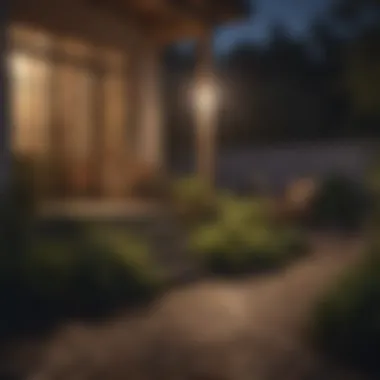

Optimal Intensity for Mosquito Deterrence
Following precise measurements of light intensity, it becomes essential to determine that optimal level which can deter mosquitoes efficiently. Studies indicate that certain light intensities, typically less than 10 lux, tend to be less attractive to mosquitoes.
- Low Intensity Recommendations: Homeowners might consider using dim lights, such as low-wattage LED bulbs, particularly around living or gathering spaces. These not only provide sufficient illumination while minimizing mosquito attraction but also enhance energy efficiency and sustainability.
- Light Color Influence: The spectrum of light can also dictate the effectiveness of various intensity levels. Lights that emit longer wavelengths, like red and yellow, tend to be less attractive as compared to those emitting blue or UV light.
- Mosquito Density Factors: The density and species of mosquitoes in a given area will also influence the effectiveness of any light intensity used. Some species are more sensitive to certain wavelengths than others, necessitating an adapted approach based on local mosquito populations.
In summary, finding the right balance in light intensity can greatly aid homeowners in reducing mosquito presence in their environments. By measuring light levels accurately and selecting optimal intensities, it becomes possible to create more inviting outdoor areas while keeping these pests at bay.
Practical Applications of Lighting
The application of lighting in deterring mosquitoes plays a critical role not only in improving outdoor comfort but also in enhancing the quality of life for homeowners. The strategic use of light serves as a proactive measure against mosquito presence, effectively reducing their likelihood of infesting personal spaces. This section delves into various aspects of how practical lighting applications can yield significant benefits in mosquito control while considering design and functionality.
Choosing the Right Lights for Outdoor Areas
Selecting appropriate lighting for outdoor areas is essential for achieving the desired effectiveness in mosquito deterrence. Different types of lights exhibit varied properties that influence mosquito behavior. For instance, certain colors may attract mosquitoes, while others may repel them.
Here are key factors to consider when choosing outdoor lights:
- Color Spectrum: Use warm white light fixtures instead of cool or blue-toned lights, as studies show mosquitoes are more drawn to cooler colors.
- Light Source Type: Opt for LED lights as they typically emit less UV radiation, making them less appealing to mosquitoes.
- Shielding and Positioning: Position lights away from commonly trafficked areas, as direct exposure may attract mosquitoes to spaces where people gather.
Furthermore, consider dimming technologies that adjust brightness according to usage and time of day. Such systems not only enhance energy efficiency but also minimize light sources that may attract nocturnal insects.
Integrating Lighting with Landscaping
The integration of lighting into landscaping serves dual purposes: enhancing the aesthetic appeal of the space while providing a barrier against mosquitoes. Thoughtful placement and design can create light patterns that discourage insect activity.
- Layered Lighting Techniques: Implement a mix of ambient, task, and accent lighting. This method can illuminate garden paths while keeping darker spots where mosquitoes may thrive.
- Utilizing Natural Elements: Place lights near plants that are known to repel mosquitoes, such as citronella or marigolds. These choices not only improve landscape design but also provide a natural barrier against pests.
- Flexible Designs: Utilize solar-powered lights that require minimal maintenance, allowing for versatile placement that complements seasonal changes in landscaping.
These practical applications of lighting directly transform outdoor spaces into more enjoyable environments while effectively managing mosquito populations.
"The key to effective mosquito control lies in combining knowledge of insect behavior with strategic lighting design."
Implementing these practical applications contributes to a multifaceted approach that incorporates scientific understanding with everyday living spaces.
Technological Innovations in Mosquito Control
Technological advancements have significant implications for mosquito control methods. Innovations, especially in lighting technology, play a crucial role in shaping effective strategies. These advancements not only help deter mosquitoes but also promote a cleaner and more sustainable environment. Incorporating smarter solutions allows homeowners to combat mosquito infestations with less reliance on chemical repellents. Here, I explore several facets of these innovations, their benefits, and considerations to effectively integrate them into mosquito management practices.
Smart Lighting Solutions
Smart lighting technology is transforming the way we approach outdoor illumination. These systems allow for precise control over lighting conditions. Homeowners can schedule lights to turn on at specific times or adjust their brightness based on surrounding light levels. This adaptability helps create an environment less favorable for mosquito activity.
A few benefits of smart lighting solutions include:
- Energy Efficiency: Smart lights, especially LED options, consume less power, reducing overall energy bills.
- Customization: Users can choose specific light colors or intensities tailored to repel mosquitoes without compromising aesthetics.
- Remote Access: Many smart lighting systems can be controlled via smartphone apps, making it easy to manage settings even from a distance.
For instance, homeowners can set their lights to emit colors that mosquitoes find less attractive, such as yellow or green. This approach reduces mosquito presence while maintaining a pleasant atmosphere for outdoor gatherings.
Emerging Research on Light-Mosquito Interaction
Research in the field of light-mosquito interaction is evolving, and scientists are uncovering new insights into how light affects mosquito behavior. Ongoing studies focus on how distinct wavelengths influence mosquito attraction and feeding habits.
Recent findings suggest the following:
- Blue Light's Attraction: Mosquitoes are drawn to certain wavelengths, particularly blue light. This can be problematic for spaces illuminated with typical white lighting.
- Red and Yellow Light: These colors are less appealing to mosquitoes, making them ideal choices for outdoor lighting solutions in mosquito-prone areas.
- Disruption of Circadian Rhythms: Light exposure might alter mosquito peak activity times, providing a period of reduced activity.
"Advancements in understanding the relationship between both light source and intensity can guide the development of proactive strategies for mosquito deterrence."
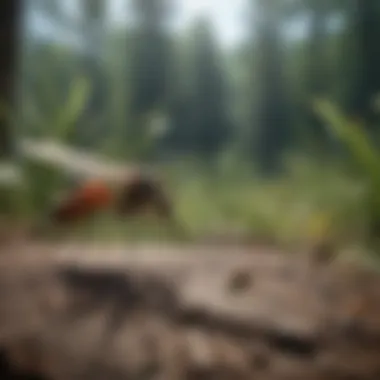

As researchers continue to explore the connections between light and mosquito behavior, future innovations are likely to emerge that harness these findings. Homeowners can stay ahead of the curve by adopting practices influenced by the latest science.
Environmental Considerations
Understanding the environmental implications of using light as a mosquito deterrent is crucial. The selection and application of light sources have direct impacts not just on the immediate area but also on surrounding ecosystems. Considering these factors can aid homeowners and enthusiasts in making informed choices that promote both comfort and ecological integrity.
Sustainability of Lighting Choices
Sustainability is a vital component when exploring various lighting options for mosquito control. Selecting energy-efficient lighting can lower electricity consumption, which is critical in minimizing the carbon footprint. For example, LED lights are well-known for their longevity and efficiency. They use substantially less energy compared to incandescent bulbs, providing the same amount of light while producing less heat.
- Energy Consumption: Reducing energy use is not just beneficial for the environment but also for your wallet. Opting for solar-powered lights can enhance sustainability further, relying on renewable energy sources.
- Material Life Cycle: When choosing lighting fixtures, consider their material and production process. Look for products that use recycled materials or have designs intended for durability and recyclability. This consideration reduces waste and promotes responsible sourcing.
- Impact on Surrounding Wildlife: While employing light to deter mosquitoes, ensure that the selected light sources do not affect other insects that play beneficial roles in the ecosystem. This will maintain the balance between controlling pests and preserving essential wildlife.
Sustainable practices in lighting not only contribute to mosquito deterrence but also reflect a commitment to environmental stewardship.
Impact of Light Pollution on Ecosystems
Light pollution is an often-overlooked consequence of artificial lighting. It can disrupt natural behaviors in wildlife, including feeding patterns, mating rituals, and migratory movements. Understanding these impacts is crucial for creating an environment that is harmonious for both humans and wildlife.
"Excessive artificial light can alter the natural rhythms of the environment, posing risks to various species."
- Disruption of Natural Habitats: Artificial lights can confuse nocturnal creatures. Birds, insects, and mammals may be affected, leading to altered feeding and breeding patterns, which can upset local ecosystems.
- Increased Predator Visibility: For some species, increased light can make them more visible to predators. This dynamic can lead to a decline in populations of certain animal species, further affecting the food web.
- Human Health Concerns: Light pollution does not only impact wildlife; it also affects human health. Disrupted sleep patterns due to excessive outdoor lighting can lead to various health issues. Homeowners should strive to strike a balance between effective mosquito deterrence and maintaining a natural night environment.
Case Studies: Effective Use of Light against Mosquitoes
Understanding how light can be effectively utilized to deter mosquitoes requires examining real-world applications. Case studies provide valuable insights into practical implementations and outcomes in homes and communities. This section discusses specific homeowner experiences and community initiatives that demonstrate the success of using light as a deterrent against mosquitoes. Each case exemplifies the potential benefits, considerations, and strategies that can be replicated to create effective mosquito control measures.
Homeowner Experiences
Homeowners have reported varied success when implementing specific lighting strategies to repel mosquitoes. Many have integrated LED light fixtures around their outdoor spaces with observable results. For instance, one homeowner in Florida noted a significant reduction in mosquito activity after replacing their standard porch lights with yellow-tinted LED bulbs. This color choice not only aesthetically enhanced their outdoor space but also effectively reduced the number of mosquitoes that frequented the area during warm evenings.
Another homeowner shared their experience of installing solar-powered lights along a garden path. The soft light emitted by these fixtures created a welcoming ambiance while minimizing direct exposure to mosquitoes. Through a combination of landscaping and light placement, the homeowner was able to enjoy evening gatherings without the interruption of pests. Key takeaways from these individual accounts include the importance of experimenting with different light colors and intensities, as well as strategic placement of lighting solutions to maximize effectiveness.
Community Initiatives
Community-led initiatives further illustrate the collective impact of using light to combat mosquito populations. In some urban areas, communities have adopted neighborhood-wide lighting programs focused on reducing mosquito breeding in common spaces. For example, in Austin, Texas, a community initiative implemented bright LED street lighting to deter mosquitoes in public parks. Residents reported a noticeable decrease in mosquito-related complaints during the summer months, thanks in part to this proactive approach.
Furthermore, some communities have collaborated with local government to fund mosquito control studies. These efforts have involved the installation of various lighting types in designated areas to analyze their effectiveness. The data gathered from these studies not only helps refine lighting techniques but also fosters community engagement around public health issues.
“Addressing mosquito populations is not only about personal solutions; it requires community involvement and shared responsibility.”
Community initiatives highlight the importance of collaboration. By raising awareness and implementing light-based strategies, residents can create healthier outdoor environments. Through various case studies, both individual and community-led approaches convey clear benefits. The evidence supports that effective lighting solutions can significantly contribute to mosquito deterrence, providing a sustainable way to enjoy outdoor spaces.
End and Future Outlook
The information gathered highlights the importance of choosing the right lighting. By recognizing which lights deter mosquitoes, individuals can tailor their outdoor environments. For instance, utilizing LED lighting in warm colors may actively reduce mosquito attraction, encouraging more enjoyable evenings outdoors.
Moreover, the exploration of light intensity and color serves as an essential aspect to keep in mind. Higher intensities in certain spectrums may be effective, but considering their ecological impact is equally important. It leads to a better understanding of how to create outdoor spaces that are both captivating and mosquito-free.
Effective light management not only reduces mosquitoes but also promotes a harmonious living environment.
Summarizing Key Findings
The article has detailed several critical findings regarding the effectiveness of light in Mosquito control:
- Different light sources impact mosquito behavior significantly. Choices should include LED, incandescent, and fluorescent light in specific colors.
- Warm lights tend to be less attractive to mosquitoes. On the other hand, cool lights can draw them in, reducing outdoor comfort.
- Proper light intensity enhances deterrence, but it needs to be balanced with ecological considerations to avoid harming other beneficial insects.
- Integrating lighting with landscaping not only provides aesthetic benefits but enhances mosquito deterrence strategies.
Potential for Further Research
While the existing research provides valuable insights, the potential for further study in this area is substantial. Future research could focus on:
- Expanding the understanding of how varying wavelengths of light can be manipulated to affect mosquito behaviors more effectively.
- Investigating the long-term ecological impacts of various lighting choices on not just mosquitoes but the overall insect ecosystem.
- Exploring smart lighting technologies that can adapt based on environmental conditions for optimized mosquito control.
Addressing these areas can lead to more robust solutions and innovative technologies that further promote effective mosquito deterrence through lighting strategies.



